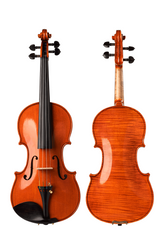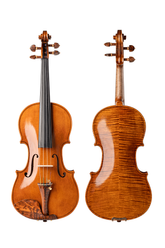Origins of violin making in Cremona: Amati Family
From the 15th century until today, Cremona in Italy has been the center for the production and restoration of stringed instruments. Its renowned tradition of love and dedication to music has made Cremona famous worldwide. Its glorious origins can be traced back to Andrea Amati, the founder of the Amati family and the pioneer of the Cremonese school of violin making.
Table of Contents
The Cremona School of Violin Making
The founder of the Cremonese school of violin-making was Andrea Amati (1505-1577). His descendants and members of his family lineage trained apprentices who became renowned masters of violin making. In addition to the Amati family, this school included the Stradivari family, the Guarneri family, and the German violin maker Jacob Stainer. etc
Andrea Amati: creator of the violin
We may never know for certain about the exact creators of the modern violin. In a book published in 1940 called "Violin and Violinist," Franz Farga stated that Andrea Amati was born in 1535 and suggested that Gasparoda Salò (1542-1609) from the Brescia school might have been one of the inventors of the violin. However, recent discoveries have pushed Andrea's birth year back by thirty years, aligning it with the possible birthplace of the violin in northern Italy. Consequently, contemporary scholars tend to consider Andrea Amati as the creator of the modern violin. However, we do not have concrete information regarding the location and mentorship of his violin-making education, only some speculations and legends.

The "Kurtz" violin by Andrea Amati, which is currently housed in the collection of the Metropolitan Museum of Art in New York, is considered to be the earliest surviving Amati violin to date, crafted around 1560. This violin is part of a set of seven instruments gifted to celebrate the marriage of 14-year-old Elisabeth de Valois and King Philip II of Spain in 1559. Elisabeth was the daughter of Catherine de' Medici and Henry II, and her brother later became the King of France. He commissioned 38 instruments from Andrea Amati, including 24 violins, 6 violas, and 8 cellos. These instruments were adorned with the fleur-de-lis, a symbol of the French royal family, and featured intricate designs on the back and sides.

Unfortunately, by the time Andrea Amati crafted these instruments, he had already reached a remarkable level of expertise, and we are unable to see his earlier works or understand his process of experimentation and refinement. This gives the impression that the creation of the violin appeared suddenly as if inspired by a stroke of genius.
Andrea Amati crafted over 200 instruments during his lifetime, but only a few have survived. One of the reasons for this scarcity is that during the 16th century, the music played on the violin was not fully accepted by the Church. In northern Italy, there were even bans on the violin and instances of instruments being destroyed. However, the situation changed completely in the following century.
The surviving instruments by Andrea Amati can be broadly categorized into three types.

The first type consists of a set of stringed instruments made for King Charles IX of France, adorned with oil paintings and decorations, bearing the royal motto "Pietate et Justitiae." An example of this type is the "King" Cello.
The second type comprises instruments created to celebrate royal marriages, featuring ornamental decorations and inscriptions such as "Quo unico propugnaculo stat stabiq[ue] religio" (By this bulwark alone religion stands and will stand). An example of this type is the ex"Kurtz" violin.
The third type includes instruments with no decorations at all and those with textual decorations that do not belong to the first two categories.
Andrea Amati ingeniously used four strings and designed the basic shape of the violin, which served as the foundation for subsequent improvements. He is widely regarded as the father of the violin. He established the Amati family, and his craftsmanship did not disappear with his passing. Instead, it was carried on and further developed by his two sons, Antonio Amati (1537 - c. 1607) and Girolamo Amati (1561-1630). They continued the legacy and dominance of the Cremonese stringed instrument-making for over a century, making significant contributions to the evolution of the modern violin pattern.
Antonio Amati and Girolamo Amati: inheritors of violin-making craftsmanship

Antonio Amati (1537-c. 1607) and Girolamo Amati (1561-1630), the two brothers, learned violin making from their father, Antonio Amati, from a young age. They fully inherited their father's craftsmanship and both became renowned master luthiers, collaborating throughout their lives. Their jointly signed works range from 1590 to 1630, bearing the Latinized names "Antonius & Hieronymus Amati." In reality, Antonio had passed away before Girolamo died in 1630.
Neither Andrea Amati nor his sons Antonio and Girolamo took on apprentices, possibly due to their reluctance to pass on their skills and knowledge. Girolamo, his wife, and two daughters were victims of the widespread plague in Cremona in 1630. However, he had a son, Nicola Amati (1596-1684), who continued the family legacy, becoming the master of the workshop and achieving even greater prestige than his ancestors during his career.
Nicola Amati: Promoter of family craftsmanship

Nicola Amati (1596-1684) was an incredibly significant master in the history of violin making. It is not only due to his exceptional craftsmanship but also because of his contribution to the development and dissemination of the Amati family's violin-making techniques that the violin achieved its brilliance in later years.
During Nicola Amati's era, the violin family became one of the primary instruments due to the development of opera, the rise of chamber music, and the standardization of symphony orchestras. As a result, the demand for violins increased steadily. The fame of violin-making in Cremona spread over time. Meanwhile, the Amati family's craftsmanship and dedication paid off, as they received a growing number of orders from various Italian duchies and even from distant places. The increasing demand required higher production, but Master Nicola Amati was the sole craftsman, without anyone in the family to assist him.
The increase in orders compelled Master Nicola Amati to make a significant decision by breaking away from the traditional practice of keeping the family's violin-making techniques within the family. He chose to take on apprentices and pass on his craft and knowledge, which had a profound impact on the history of violin making. Among his apprentices were Jacob Stainer, Antonio Stradivari (1644-1737), and Andrea Guarneri (1626-1698), the founder of the Guarneri family. Later, his grandson, Giuseppe Guarneri "del Gesu" (1698-1744), became a master violin maker who rivaled Antonio Stradivari in skill and reputation.
Girolamo (or Hieronymus) Amati II: Last Glory

Girolamo (or Hieronymus) Amati II (1649-1740), the eldest son of Nicolò Amati, is believed to have been an underestimated apprentice of Nicolò Amati. He learned the craft and acquired extensive knowledge from his father at a young age, showcasing exceptional violin-making skills evident in his limited body of work. However, it is speculated that due to Nicolò Amati's amassed wealth throughout his lifetime, which was inherited by Girolamo, he led a comfortable life. Additionally, the intense competition in the violin-making industry during that time and possibly other factors may have prevented him from carrying on the family business. After he died in 1740, the Amati family, which had enjoyed over a century of glory, exited the stage of history.
Reference catalog:
Andrea Amati 1505 - 1577, Roger Hargrave
The Art of Violin Making, C. Johnson, R. Courtnall
Capolavori di Andrea Amati, A. Mosconi, L. C. Witten
Andrea Amati Opera Omnia, les Violons du Roi, Cremona 2007 Exibition Catalog






1 comment
Did Nicola Amati ever label the inside of his Violins as “Nicolaus Amatus Fecit in Cremona” ?